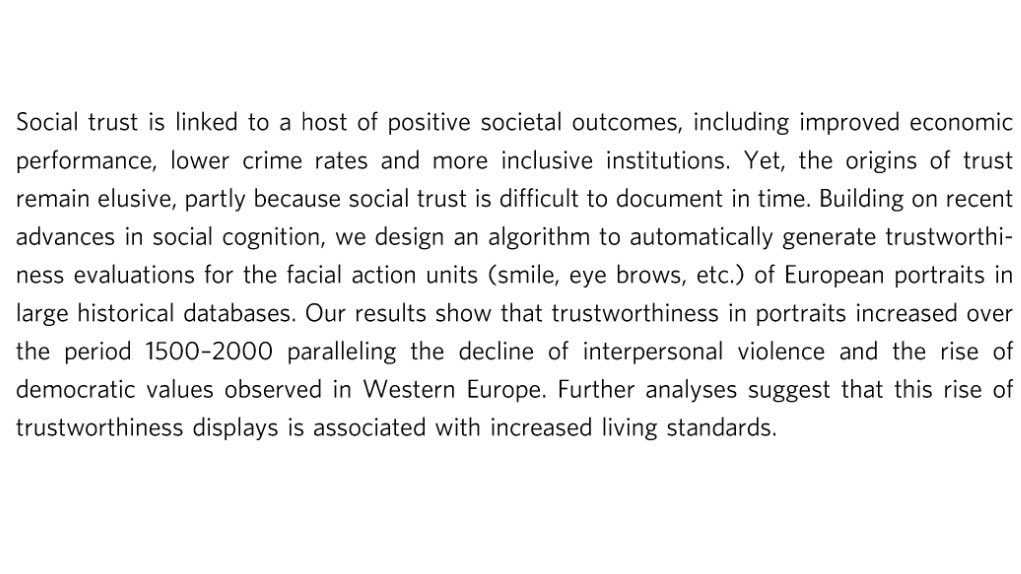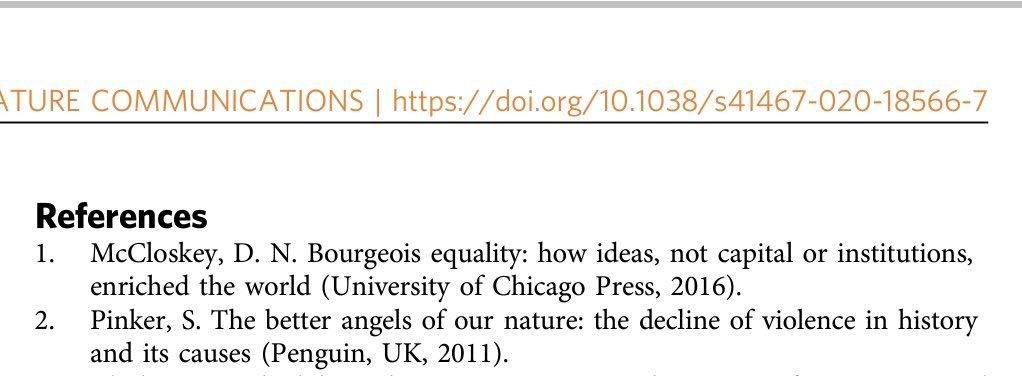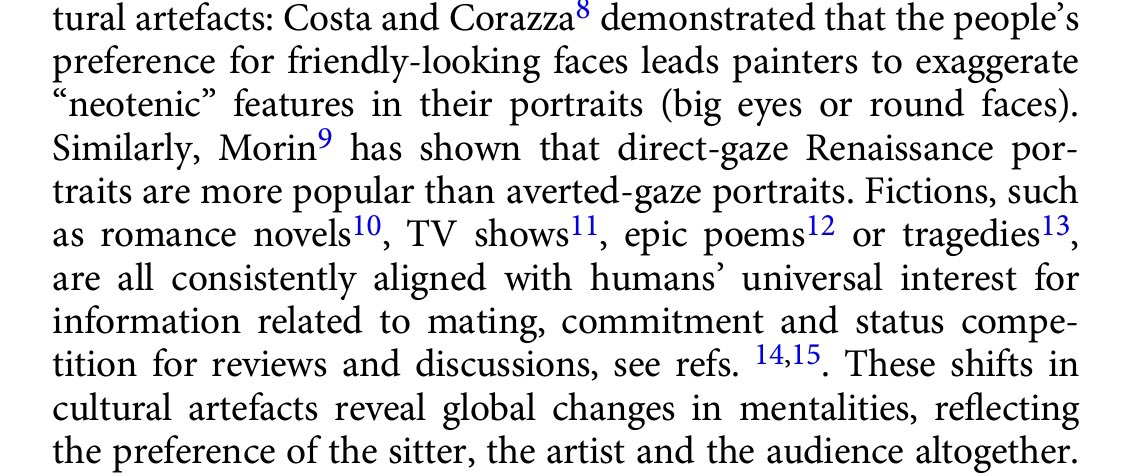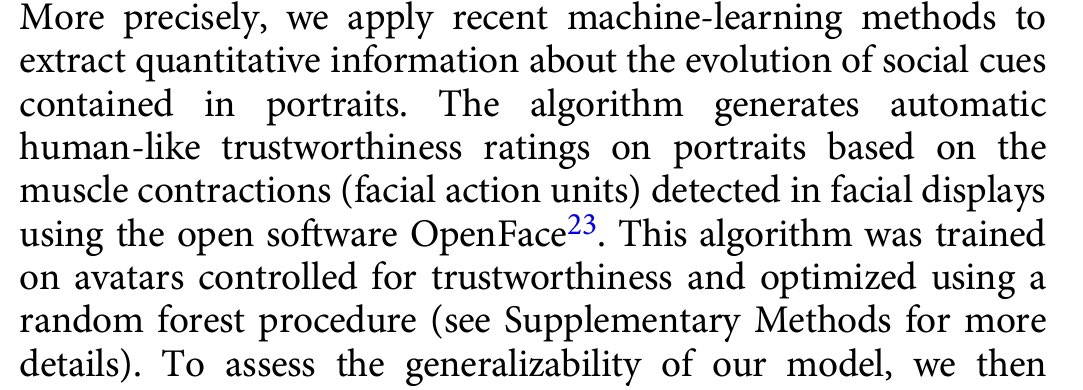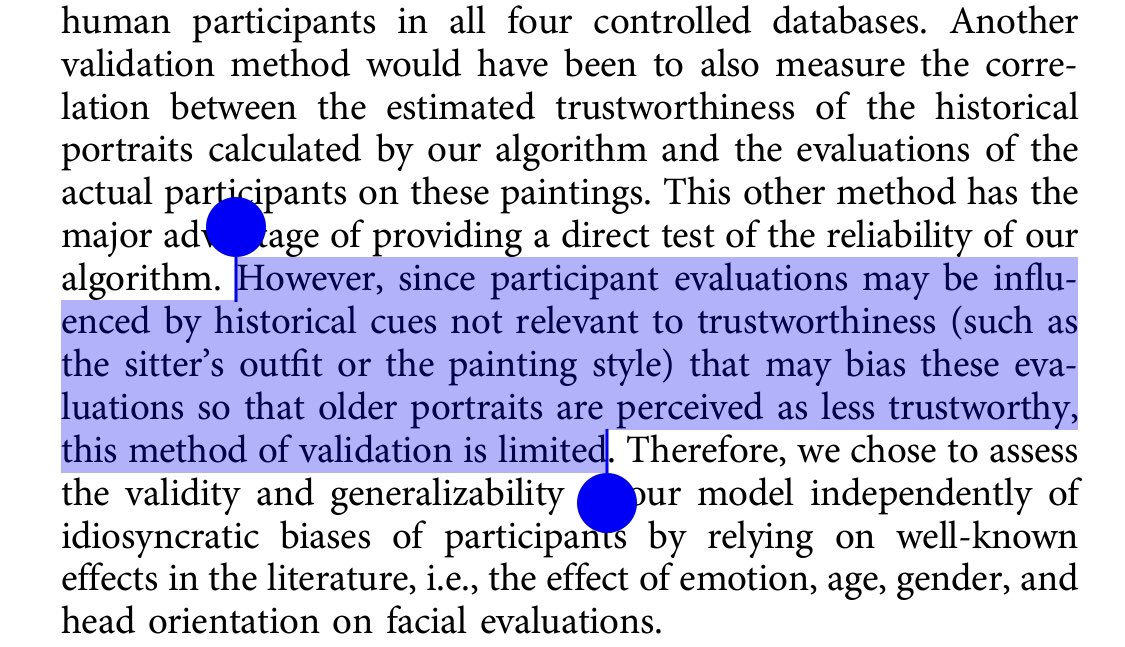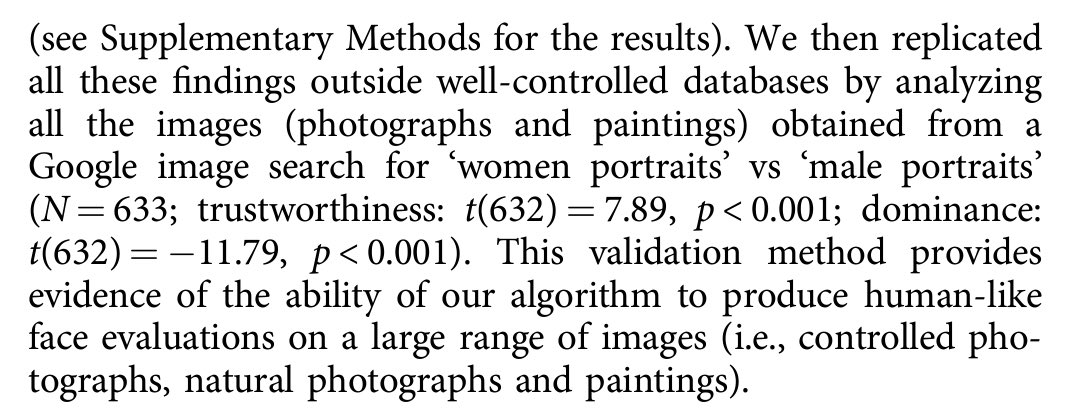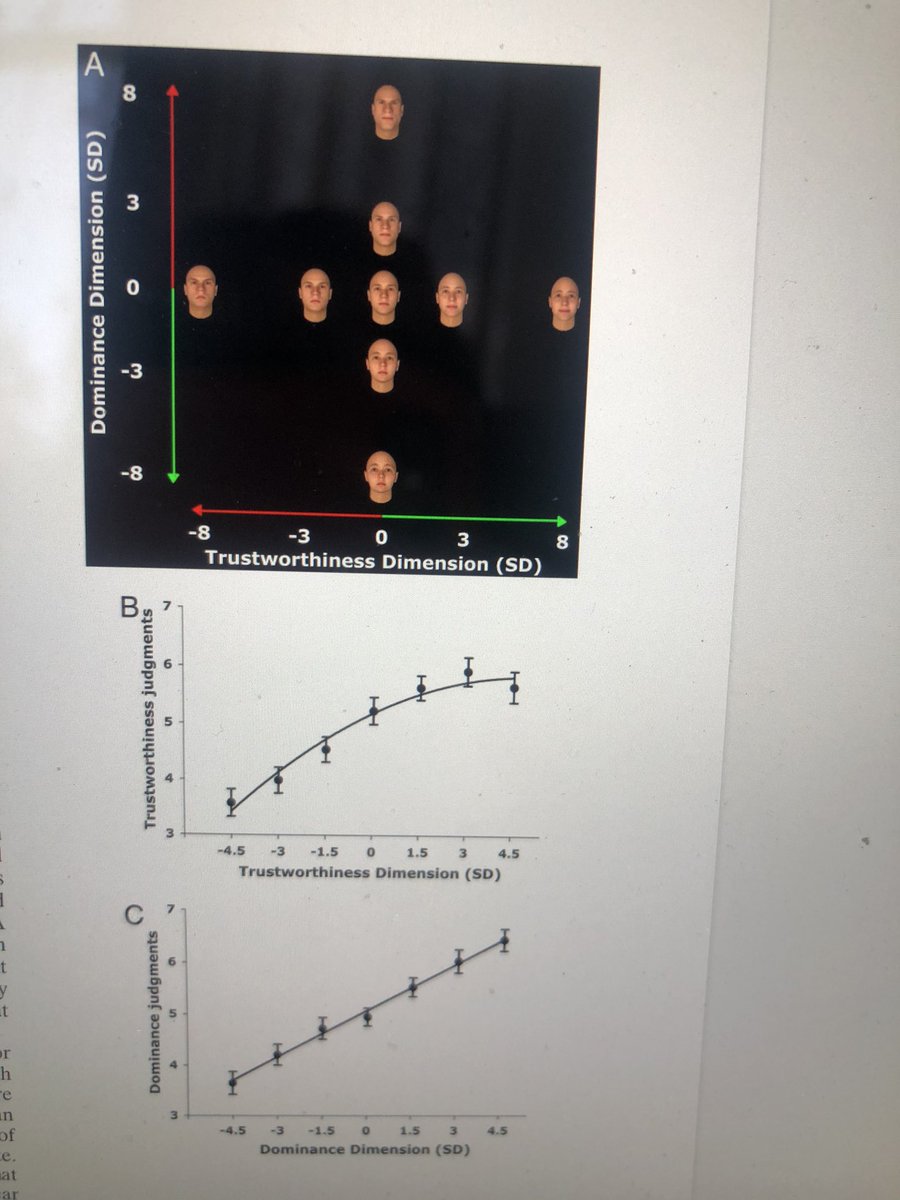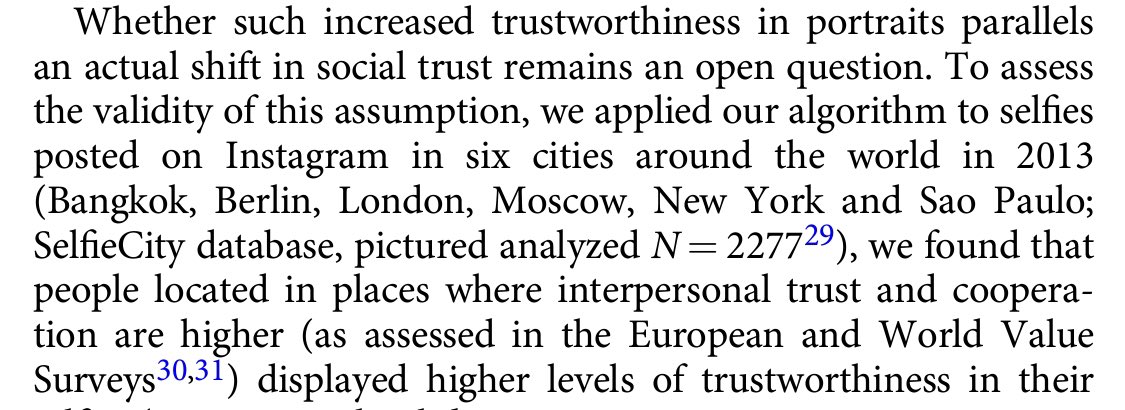Shall I read the computational phrenology paper for your entertainment?
Okay, here’s a link if you want to read along. The good news is that it’s only 7 pages including a front page and extensive references.
https://www.nature.com/articles/s41467-020-18566-7.epdf?sharing_token=TVhTE-CCpKZ8mKCO8-ILn9RgN0jAjWel9jnR3ZoTv0PTOeqztPqL6sLHm4Vi5AjV_khTW8X3qB1zF7d81ytwreuq2znTan5HExK5Evy9iVvfjUtkqc3X4dZ4sNt0IWGe9nduZM9hrGY7YU6HdWujvsQFj3qZa3-wY8KsqCRaY4w%3D">https://www.nature.com/articles/...
https://www.nature.com/articles/s41467-020-18566-7.epdf?sharing_token=TVhTE-CCpKZ8mKCO8-ILn9RgN0jAjWel9jnR3ZoTv0PTOeqztPqL6sLHm4Vi5AjV_khTW8X3qB1zF7d81ytwreuq2znTan5HExK5Evy9iVvfjUtkqc3X4dZ4sNt0IWGe9nduZM9hrGY7YU6HdWujvsQFj3qZa3-wY8KsqCRaY4w%3D">https://www.nature.com/articles/...
1. When you say “that the origins of trust remain elusive”, are you assuming that mistrust is the natural state in social relationships? Why?
2. Are you confusing “trustworthiness evaluations for facial action units” ON PAINTINGS with trustworthiness?
2. Are you confusing “trustworthiness evaluations for facial action units” ON PAINTINGS with trustworthiness?
3. What else happened in “Western Europe” between the nicely rounded years of 1500 and 2000? Where was all the interpersonal violence being directed in this period? Does the creation of whiteness and race come up in your analysis?
Guess we’ll have to read on to find out.
Guess we’ll have to read on to find out.
Wait hold on a second. Where are you establishing that “cues of trustworthiness” are the same as “trustworthiness”, and have you even defined trustworthiness, even for the purposes of your paper?
I’d like to say that this wouldn’t fly in maths, but let’s not get into that.
I’d like to say that this wouldn’t fly in maths, but let’s not get into that.
So what is happening here?
Claim 1: People say certain facial features and expressions make other people “look trustworthy”.
Q1(a) Which people? Are we talking about contemporary people, and if so how do we know people thought the same in the past.
Claim 1: People say certain facial features and expressions make other people “look trustworthy”.
Q1(a) Which people? Are we talking about contemporary people, and if so how do we know people thought the same in the past.
Q1(b) This seems like some pollster nonsense to me. People base trust on a huge bunch of factors other than facial features. If you ask them to pick out trustworthy faces or name trust inspiring facial characteristics, they may. But this does not establish “trusty face==>trust”.
Okay it’s time to look up these references to see if they answer my questions.
In [16], the abstract says that there are racial disparities in these sort of supposedly universal face m-reading skills if you strip off hairstyle and clothing.  https://abs.twimg.com/emoji/v2/... draggable="false" alt="🤔" title="Denkendes Gesicht" aria-label="Emoji: Denkendes Gesicht">
https://abs.twimg.com/emoji/v2/... draggable="false" alt="🤔" title="Denkendes Gesicht" aria-label="Emoji: Denkendes Gesicht">
In [17], the authors conclude that “without opportunities to interact with another person extensively, we use the less racially specific and more universal attractiveness cues as a shortcut for trustworthiness judgements.
[18] is about photorealistic avatars of “German” and “Arab” players in an “online trust-game”.
Is “Arab” a single culture? Is “German” a race?
Is “Arab” a single culture? Is “German” a race?
Any way these are all studies of showing contemporary study subjects photographs and and asking “d’ya trust this person”. In general I’m very sceptical of the value of this kind of science. Using a proxy of a face (photo) to measure another proxy (perception of trustworthiness).
Not to forget that a lot of these studies are about cross-cultural perceptions, ON MODERN PEOPLE WHO LIVE IN AN INTERCONNECTED WORLD.
[21] is a review that may be worth a read but is paywalled.
[21] is a review that may be worth a read but is paywalled.
Okay what does that mean? They have a data set of avatars (of real faces, but varied “along dimensions of trustworthiness on both shape and reflectance”) and they train an algo to correlate the scores they have given to the images they created to the measurements of these Avis.
This is what I don’t get. You are measuring the features that influence perception of trustworthiness (imma call this T from now on) from images that were created by manipulating features to have different values of T?
Isn’t that just measuring the biases of the people who made your test data? I’ve put in a request for the test data and will have a look. But this very strongly reminds me of a problem with the A-levels result that’s been written about quite well here. https://constantinides.net/2020/08/15/a-levels-and-gcses-in-2020/">https://constantinides.net/2020/08/1...
Okay, so once they have a proxy for T in terms for various proxies for muscle contractions of human faces, i.e. relative position of some number of dots on bitmaps of manipulated avatars, they look at the relative positions of those dots on a dataset of faces in old paintings.
And that they feed back into the formula that relates relative positions to T, and see how T varies with time the portrait was painted.
Sure, call this research if you like, who am I to judge, I don’t even have a job.
Sure, call this research if you like, who am I to judge, I don’t even have a job.
Mmkay, I’d want to see a lot more detail but what you’re saying is that the proxies of proxies of proxies you’re using aren’t too far off what you’re setting out to measure. But even so, any human who is doing any trust rating is a contemporary person. (Maybe a college student?)
So don’t your purported conclusions translate to “by modern people’s perceptions of trustworthiness, the more recent the portrait, the more trustworthy the face appears”?
But I don’t want to get ahead of myself. I did set out to give this paper a fair reading.
But I don’t want to get ahead of myself. I did set out to give this paper a fair reading.
But I do want people to keep in mind that “perceptions of trustworthiness from portraits/avatars/photos” is not the same as perceptions of trustworthiness from faces encountered in real life is not the same as actual trustworthiness, which may not be an innate unchanging quality.
I mean the confidence trickster exists for a reason. Our intuitions are unreliable.
Okay you scientifically reproduced human biases... AS THEY CURRENTLY STAND. Human biases have changed over time and have varied across cultures.
But anyway if what you are claiming is that your algorithm is as bad at reading faces as people are, I am not going to be too sceptical of your claim, but it’s also nothing to write home about.
Okay, now they are starting to look at the prevalence of T in portraits over time. But T is not assigned by the contemporaries of the people in the painting, but our contemporaries, no wait sorry, an algorithm that mimics how our contemporaries would assign T.
“Because perceived trustworthiness is correlated with perceived dominance....”
What on earth is dominance?
What on earth is dominance?
Okay, so I’m looking through the reference, [24] which starts by justifying itself with the following argument. People judge people on the basis of qualities they perceive from their faces, (so we should quantify this perception so we can control for it.)
FWIW, this idea has some merit, but the authors still seem to be rooted in evo psych, and speculate that this sort of prejudice confers some kinda “evolutionary advantage”.
They don’t define the trait they call dominance, and I’m a mathematician, not defining shit makes me mad.
They don’t define the trait they call dominance, and I’m a mathematician, not defining shit makes me mad.
Anyway back to the original paper, where “trustworthiness” appears 100 times and “perceived trustworthiness” appears twice, and the authors simply never seem to distinguish between the two.
So according to the algorithm, newer paintings have more smiling in them. This is apparently evidence of a Smile Revolution. (Which, according to the citations, were a thing that happened in France. One of the datasets under study here is English, the other pan-Western European.)
Did liberal values just steadily increase from 1500 to 2000? Again, Pinker is cited. And a couple of others. I am not a historian, I can not comment.
I am going to take a break now I need fresh air and takeaway.
And I will get to your comments, I just want to stick to the paper as I’m reading it and not get sidetracked.
I am back.
“Whether such increased trustworthiness in portraits parallels an actual shift in social trust remains an open question.”
How do they propose to settle this?
“Whether such increased trustworthiness in portraits parallels an actual shift in social trust remains an open question.”
How do they propose to settle this?

 Read on Twitter
Read on Twitter